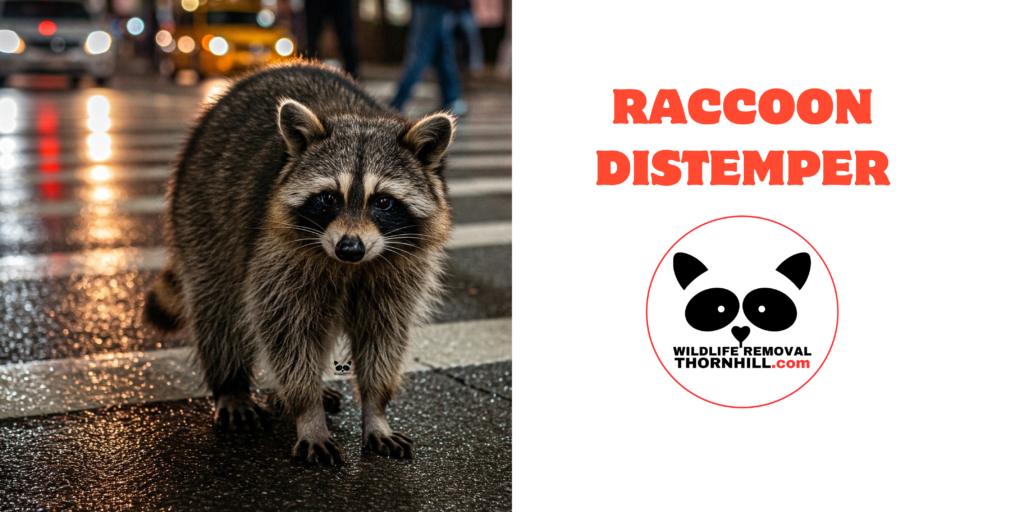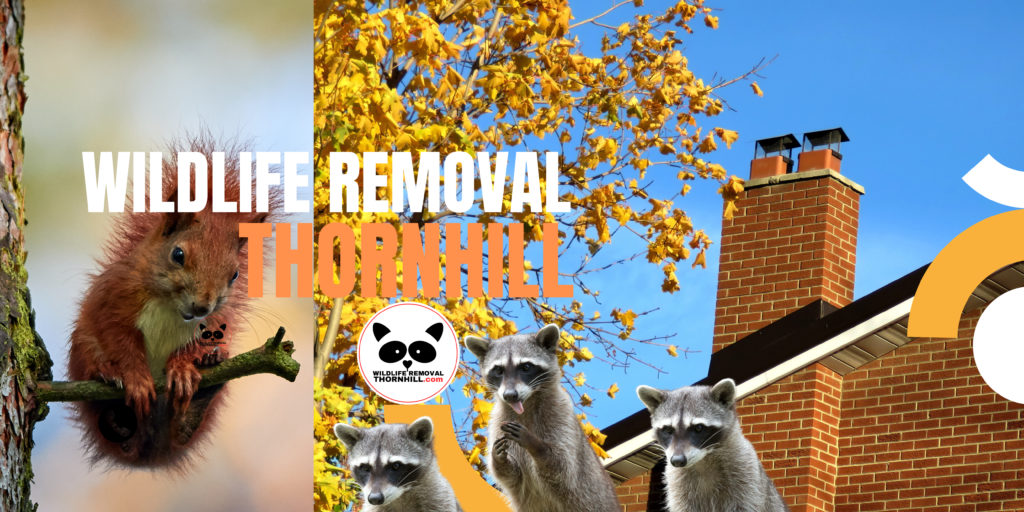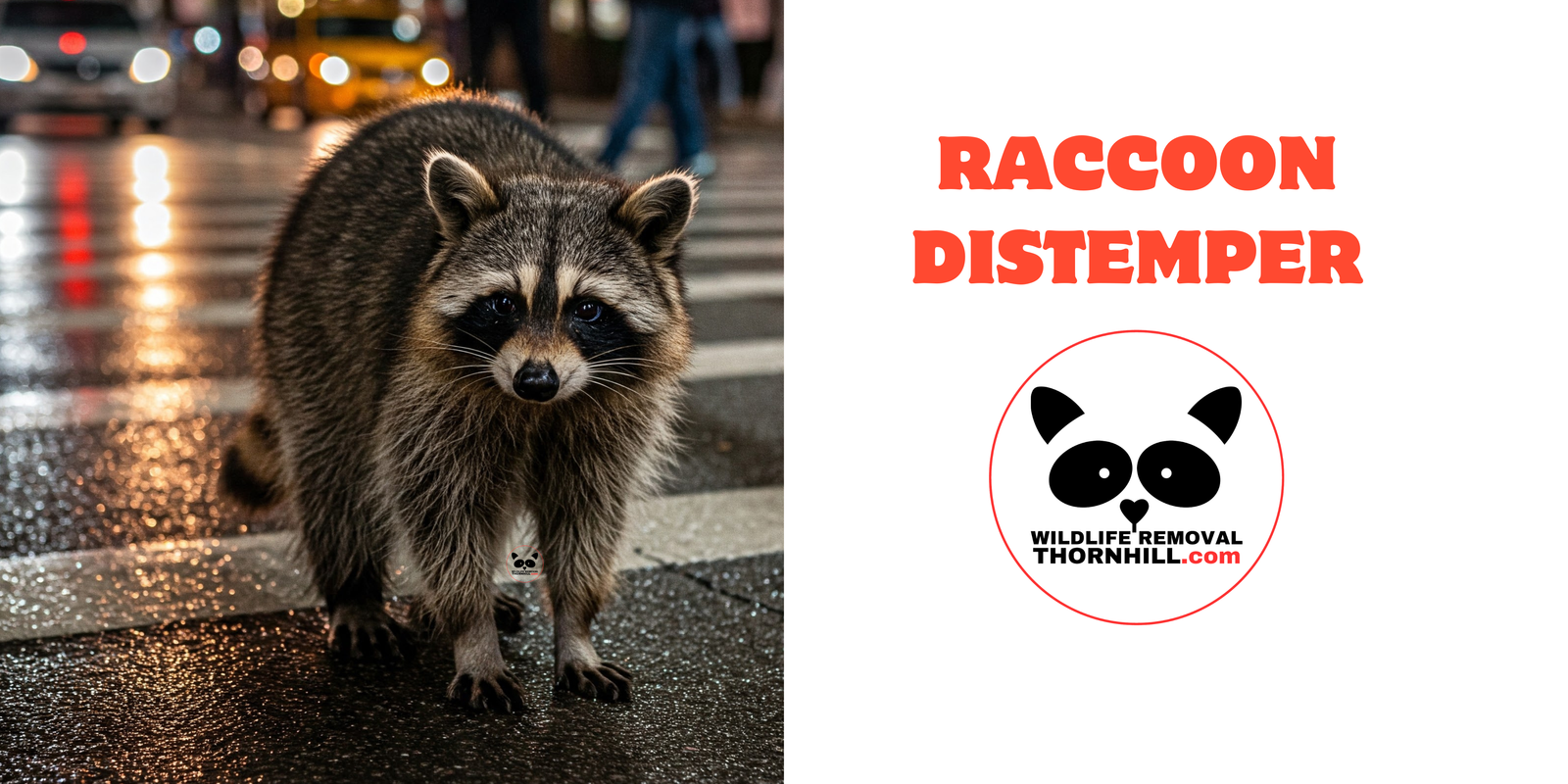Introduction
Ontario’s raccoon population has been steadily increasing, leading to more encounters between wild animals and residents. While raccoons are a natural part of the urban setting, some may display abnormal behaviour, which could indicate illness. One of the most common diseases affecting raccoons is canine distemper virus, which is highly contagious and can pose a risk to dogs, cats, and even humans. Understanding the signs of infection and the importance of animal control is crucial for maintaining public safety.
Understanding Raccoon Distemper
What is Canine Distemper?
Canine distemper is a fatal virus that is generally present in raccoons, but can also inflict skunks, foxes, and coyotes. Unlike the rabies virus, which can be transmitted to humans, distemper does not directly infect people. However, it poses a severe threat to unvaccinated pets, making it essential for pet owners to be aware of the dangers.
How Raccoons with Distemper Behave
In the early stages, infected raccoons may appear to have a mild cold, showing mucus discharge from the eyes and nose. As the disease progresses, they may generally act disoriented, wander aimlessly, or appear blind. In the late stages, they may suffer from seizures, chewing fits, or aggressive behavior. Residents notice these raccoons more often because they may be active during daylight hours, showing little or no fear of humans, whereas healthy raccoons are generally seen at night and would sooner run away than confront a person.

Normal Raccoon vs. Raccoon with Distemper
Normal Raccoon:
- Nocturnal and alert
- Avoids dogs, humans, and other animals
- Moves quickly, climbs well
- Forages in garbage, compost, and natural sources
- Lives in dens, under sheds, or trees
Raccoon with Distemper:
- Active in open areas during the day
- Disoriented, slow, or blind
- Staggers, circles, or has seizures
- May appear aggressive or overly friendly
- Shows symptoms like nasal discharge, crusted eyes
- High risk of rabies, avoid contact
Dogs and skunks can also contract distemper. Report sick animals to wildlife control.
Risks and Concerns in an Urban Environment
The Danger to Pets and Humans
Although distemper does not spread to humans, it is a serious concern for dogs and cats. Direct contact with an infected animal or exposure to areas contaminated by the virus can be dangerous, especially for pets that are not vaccinated. Raccoons in the very late stages may act unpredictably, increasing the risk of encounters with close proximity to people.
The Impact of Distemper on the Raccoon Population
During breeding season, young raccoons are particularly vulnerable to infection. Mild winter weather can also contribute to the spread of disease, as raccoons remain active longer. Unlike true hibernators, raccoons stay awake throughout the winter, increasing the chances of disease transmission. The combination of increased survival rates and illness makes wildlife removal an important tool in managing the local raccoon population.
Identifying and Responding to Infected Raccoons
Recognizing Abnormal Raccoon Behaviour
Healthy active raccoons typically avoid humans and prefer to stay hidden. A normal raccoon behaviour pattern includes being active at night and avoiding interactions with people. In contrast, a raccoon with abnormal behaviour may be seen in open areas, acting confused, or failing to respond to threats. Infected raccoons may also approach people without hesitation, a major warning sign of illness.
What to Do If You See a Sick Raccoon
If you encounter a raccoon that seems sick, do not approach it. Contact animal control or the humane society for assistance. In cases where a raccoon is suffering greatly and beyond recovery, humane euthanasia may be necessary to prevent further suffering. Wildlife professionals follow ethical guidelines to ensure that removal is handled responsibly.
Prevention and Protecting Your Home
Avoid Feeding Raccoons
One of the main reasons raccoons gather in residential areas is because people feed them, either intentionally or by leaving out food sources like garbage or pet bowls. Reducing access to food can help prevent raccoons from coming too close to homes.
Vaccinating Pets and Avoiding Contact
Keeping dogs and cats vaccinated against canine distemper is one of the best ways to protect them. Pet owners should also avoid letting their animals roam unsupervised, especially in areas where sick raccoons have been spotted.
Professional Wildlife Removal in Brampton
For long-term control, wildlife removal services can help safely and humanely manage the raccoon population. Wildlife professionals conduct thorough inspections, remove sick or nuisance raccoons, and provide strategies to deter future wildlife intrusions.
Conclusion
Distemper is a highly contagious disease that poses a serious threat to pets and can cause distressing symptoms in raccoons. Understanding the signs of infection and avoiding direct contact with infected raccoons is crucial. If you notice symptoms such as exhibiting abnormal aggressive behaviour, mucus discharge from their eyes and nose, seemingly confused or having seizures, wandering aimlessly, or if they’re showing signs of blindness, it is very important to contact animal control or a humane society. By taking preventative steps, including securing edible sources and keeping pets vaccinated, Ontario residents can help reduce the spread of this virus and maintain a safer environment for both humans and wildlife.

